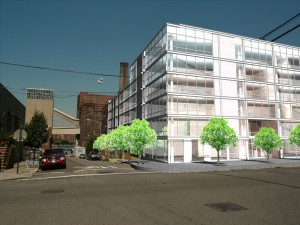City approved developer’s request to rezone 15 tax lots to facilitate the development of two, six-story buildings near site of Domino Sugar project. Bruce Terzano (through JBJ, LLC) sought City approval to build a two-building mixed-use project at the corner of Wythe Avenue and South 3rd Street in Williamsburg, Brooklyn. To facilitate his proposal, Terzano asked the City to expand a nearby MX-8 special mixed-use district to include 15 tax lots on the eastern portion of the block bounded by South 2nd and South 3rd Streets between Wythe and Kent Avenues, and rezone the blocks from M3-1 to MX8:M1-4/R6A. Terzano needed the rezoning in order to replace a parking lot and low-rise plumbing supply store with two, six-story buildings, providing 18 affordable apartments, 61 market-rate apartments, and ground floor commercial space.
The proposal was met with opposition from the local community during the ULURP review process. Brooklyn Community Board 1 opposed the proposal, recommending that the area be rezoned to M1-4/R6B, and that Terzano record a deed restriction excluding bars and restaurants from the development’s commercial space. At the City Planning Commission’s public hearing, Brandon Cole, president of the Williamsburg Community Preservation Committee, asked the City to postpone the “spot” rezoning and perform a comprehensive study of the neighborhood similar to the study carried out prior to the 2005 Greenpoint-Williamsburg Rezoning plan.
The Planning Commission approved the proposal without modification, noting that the surrounding zoning districts permitted heights and bulk similar to or greater than the proposed rezoning area. One month later, the City Council unanimously approved the proposal.
The Williamsburg Community Preservation Coalition filed an article 78 petition challenging the City’s approval. The Coalition argued that the rezoning violated State law because it had not been part of a well-considered plan. According to the Coalition, the rezoning’s R6A residential designation was out-of-context with the area and inappropriate for narrow streets, such as South 2nd and South 3rd Streets. The Coalition claimed the City should have followed the example of an earlier rezoning of Grand Street, which applied a lower density R6B district to five blocks of Grand Street between Berry Street and Marcy Avenue. The Coalition also argued that the City did not comply with State and City environmental review requirements because it failed to consider the aggregated environmental impacts of possible future rezonings subsequent to Terzano’s rezoning proposal.
State Supreme Court Justice Carol R. Edmead dismissed the challenge. Justice Edmead found that the rezoning had been part of a well-considered plan, citing the Planning Commission’s report approving the proposal and an affidavit from Steven Lenard, an urban planner at City Planning, which described the contrasting purposes of Terzano’s proposal and the earlier rezoning of Grand Street. Lenard stated that the purpose of the Grand Street rezoning was to preserve the existing low- to mid-rise context along the corridor, while the purpose of Terzano’s proposal was to facilitate the development of an underutilized parcel in a way that would contribute to the orderly growth of a changing area.
Justice Edmead also found that the City took a hard look at the potential impacts of the proposal and offered a reasoned elaboration for its approval. Contrary to the Coalition’s assertions, Justice Edmead found that the City or State environmental review laws did not require the City to aggregate the impacts of possible future rezonings when analyzing the impacts of a discrete, small-scale rezoning.
Williamsburg Community Preservation Coalition v. City of New York, 2012 N.Y. Slip Op. 50827U (N.Y. Cty. Sup. Ct. May 9, 2012) (Edmead J.) (Attorneys: Allyson M. Phillips for Coalition; Michael A. Cardozo and Diana M. Murray for NYC; Cozen O’Connor for Terzano).



